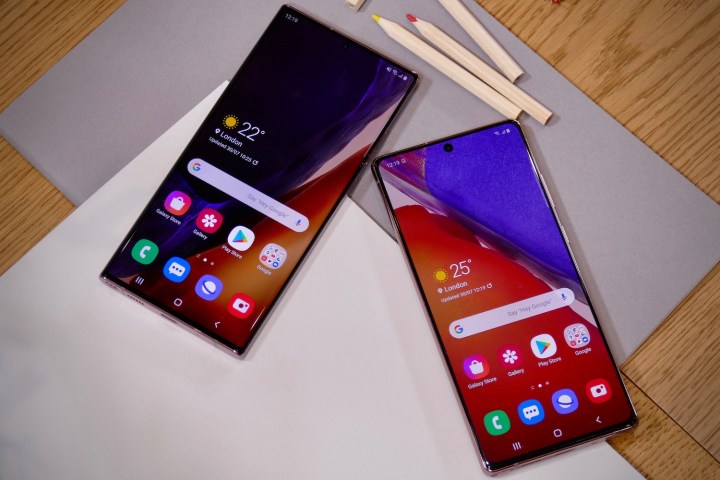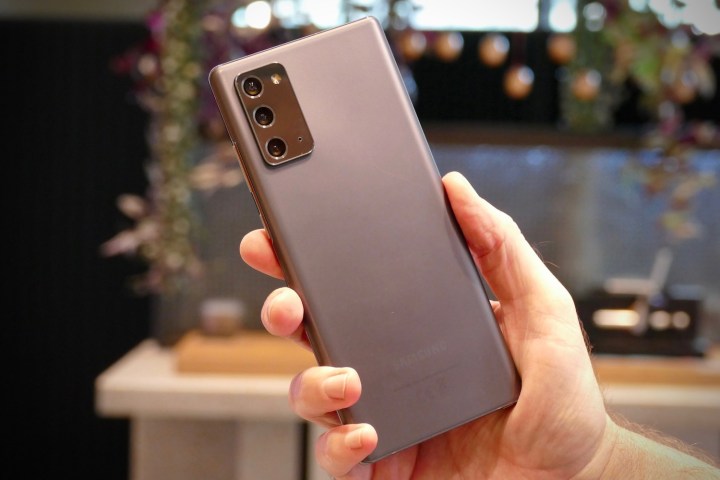There are many reasons to love Samsung. It has a broad range of good (often great) devices, solid software, and the ability to interconnect smart devices better than most Android manufacturers — but the Samsung Galaxy Note 20 is not one of the reasons. In fact, it’s a terrible smartphone, and after swapping to the Google Pixel 7 Pro, I can finally purge myself of this experience and move on.
The Samsung Galaxy Note 20 was one of the worst phones I’ve ever used, and you should thank your good fortune if you didn’t buy it. If you did, I feel your pain.
The Note 20 was already the unloved sibling
Right from the start, there were signs Samsung wasn’t trying as hard with the Galaxy Note 20. The second of two models in the Galaxy Note range’s swansong, the Note 20 was undeniably the poorer of the two. The larger model, the Galaxy Note 20 Ultra, got a glass and metal build, a larger display with a higher refresh rate, and a much more capable camera. Digital Trends’ Andy Boxall loved it, pronouncing it the best Android smartphone of the time. Samsung had pulled out all of the stops.
Unfortunately, it had firmly pushed the stops back into the Note 20. It wasn’t a bad-looking phone, but it wasn’t up to the standards of its $1,000 price tag — even in 2020. The back was plastic, the display was limited to 60Hz, and it was missing the camera tricks that made the Note 20 Ultra shine. It wasn’t a bad setup, but it wasn’t a $1,000 spec sheet.
Right from the start, there were signs Samsung wasn’t trying as hard with the Galaxy Note 20.
But in spite of all that, I was excited to use it. The Mystic Green colorway was gorgeous, and it had the S Pen — an accessory I’d wanted since coveting my coworker’s (admittedly, short-lived) Galaxy Note 8. I thought I could work past the Note 20’s obvious flaws. I was going to slap a case on it (so a plastic build was forgivable), a 60Hz refresh rate is fine when you haven’t used anything faster, and heck, I could live without the more advanced camera too.
Maybe I would have been fine if those had been all I had to contend with. Unfortunately, those weren’t the worst flaws. The biggest issue wouldn’t be obvious until I’d played with it for a while.
It un-cured my battery anxiety

These days, it’s common for a smartphone’s battery life to improve as software gets used to your daily activities. That’s why I wasn’t too worried when the Note 20 initially exhibited some pretty terrible battery life. “It’ll get better,” I told myself, plugging the phone in to charge at 3 p.m. “There’s no way a 4,300mAh battery can be this bad. The software will kick in and fix this.”
Reader, it did not.
I’d previously suffered from battery anxiety, as most of us did. Battery tech wasn’t quite there at the dawn of the smartphone era, so we were all used to needing to plug in fairly regularly. Increased battery sizes, faster charging, and better software have largely eroded battery anxiety for most of us. Mine was cured by the Google Pixel 3a XL, which was a stellar smartphone with excellent battery life.
The Samsung Galaxy Note 20 single-handedly undid all that. Even from new, it struggled to get a day out of a full charge. A 20-minute dog walk with podcasts would wipe off almost 10% from a freshly charged phone. As a seasoned pro, I went into battery-saving maneuvers, switching off the always-on display, and ratcheting down the brightness to the point where I had to squint to see the screen.
Even from new, the Note 20 struggled to get a day out of a full charge.
It helped a little, but it still needed more to become somewhat acceptable. The nuclear option then: Battery saver. I kept that mode on for the next two years, but even then, it would barely make it to the end of the day. I often found myself plugging the Note 20 in during the early evening, knowing it wouldn’t otherwise make it to bedtime.
I was thankful my life generally revolved around a desk because I did not like being away from charging cables. Outside the house, portable batteries became constant companions. I would take my charging cables to friends’ houses with me, shamefully plugging in, away from prying eyes. Thank God, Samsung shipped this phone with a 25W charging brick, because I’m not sure I’d have spent time away from the charger otherwise.
Long periods of social media? Not without keeping an eye on the top-right corner. Videos? Probably best avoided. Games? You’re joking, right?
An uninspired piece of mobile tech

A rubbish battery is a pretty strong red line for me, but perhaps my time could have been made easier if the phone excelled in other areas. Samsung had shipped the phone with some cosmetic drawbacks, so surely, the other areas were good?
Well, sort of.
My Galaxy Note 20 is technically Mystic Green, but its soul is beige. It’s the color you paint on walls because it’s inoffensive and because your sight slides off it without leaving any lasting impression. Using the Galaxy Note 20 was a bit like that. It was serviceable. It worked. Performance was, yeah, fine. The camera took good pictures. The display was gorgeous. Alright, Samsung continues to excel at screen tech — but the lack of a 90Hz or 120Hz refresh rate still rankled.
On the plus side, because everything else was so bland, I didn’t really notice it was such an uninspiring smartphone — until I started using the Google Pixel 7 Pro.
A bright new dawn

Using Google’s phone was like a light going on. I was excited to take pictures, started playing games again, and spent more time on Twitter than ever before. Yes, the Pixel 7 Pro has problems, and I have run into more than a few of them. But like the most fun of friends, it’s bright and dazzling, even if it is a little bit dumb. I get annoyed at the bugs, but it’s always worth forcing my way through them for the good bits. It’s so much better than the gray, colorless existence of the Note 20.
In a final, cruel joke by the universe, my Note 20’s charging port started giving out too. I should salute that humble USB-C port for its service, really. It was the hardest working part of that phone by a long shot.
Goodbye, Samsung Galaxy Note 20. You were a terrible phone, and you will not be missed.
Editors’ Recommendations

